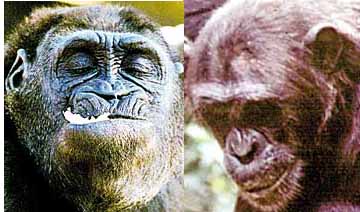Gorillas are now rare animals. Illegal hunters kill the adult gorillas and eat their meat. The young women are taken from the wild to decorate private zoos. But even after a hundred years, the dwindling gorilla population still holds surprises.
Economist, Haaretz (Wala!)
One hundred years ago, on October 17, 1902, while climbing a volcano in the Congo, the German researcher Oskar von Bering suddenly noticed a group of large black monkeys. "We managed to shoot two of the monkeys, who shook the crater of the volcano with fierce growls," he wrote. The fact that von Bering was unable to determine the species of the monkeys is not surprising. He was the first European to see a mountain gorilla.
Gorillas are now rare animals. Illegal hunters kill the adult gorillas and eat their meat. The young women are taken from the wild to decorate private zoos. But even after a hundred years, the dwindling gorilla population still holds surprises.
In 1908, two monkeys were shot near a place called Bundo, in northern Congo. The two skulls (and two additional skulls found in houses in the area) were similar in some of their characteristics to gorilla skulls (for example, they had bony carpels, which are characteristic of gorillas), but other, unique characteristics caused researchers of the time to classify the apes as a separate subspecies. Since then no further examples of this subspecies have been recorded. Four years ago, Carl Amann, a Swedish nature photographer, decided to discover, or rediscover, the disappearing gorillas. The scientific status of his discoveries is still unclear, but Amman may have discovered a new species of great ape.
Aman went with several expeditions to the Bili forest near Bundo (the last expedition, which recently returned from Africa, was joined by the "Economist" reporter). None of the expeditions were able to see live monkeys, but they discovered many ground nests. Nests of this type are typical of gorillas. Chimpanzees, the other great apes that live in the area, prefer to sleep high in the trees. Additional footprints also indicate the presence of gorillas. Faecal droppings discovered in the area are similar to gorilla droppings, as is the typical breaking of young tree branches around the nests. Amman also discovered another skull with a skull in the vicinity
Closed.
Hairs were discovered in some of the nests - and hairs contain DNA. Here was hidden a surprise: the DNA was similar to the DNA of a chimpanzee, not a gorilla. Furthermore, an analysis of the skull Shaman discovered revealed that it was a chimpanzee skull, which had a bony carapace. And an analysis of the faeces revealed that the animal that produced them fed on fruits - another characteristic of chimpanzees. Aman seems to have discovered a chimpanzee that behaves like a gorilla.
Reports from local hunters also indicate an unusual phenomenon. The hunters in Bundo do not differentiate between gorillas and chimpanzees. They divide the local monkeys into "climbers of trees" and "killers of lions". These two types of monkeys look the same, and both are running away from hunters. But according to Billy's hunters, lion killers are much larger and difficult to kill, even with a poisoned arrow. Some enormous footprints of chimpanzees apparently corroborate hunters' reports of an exceptionally large chimpanzee. In addition, a photo obtained recently from a hunter shows a chimpanzee that is about one and a half meters tall. Indeed, in order to be able to sleep safely on the ground in a forest infested with lions and tigers, lion-killing monkeys of such proportions are required.
It is still impossible to know if the monkeys that kill the lions are indeed a different population - the "chimpanzees" that build Amman's ground nests - or if the difference between them and other great apes means that it is a separate species. But it is surprising that in the first years of the 21st century it is still possible to think of a discovery of this kind. Apparently, the jungle has not yet revealed all its secrets.
https://www.hayadan.org.il/BuildaGate4/general2/data_card.php?Cat=~~~352415257~~~51&SiteName=hayadan

